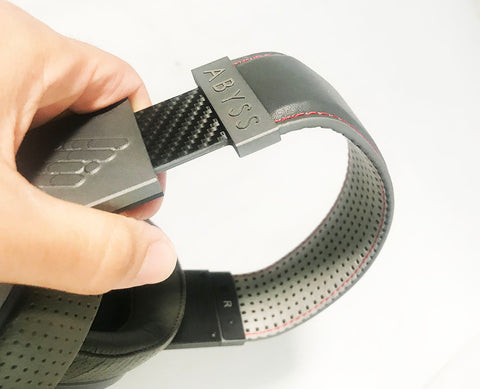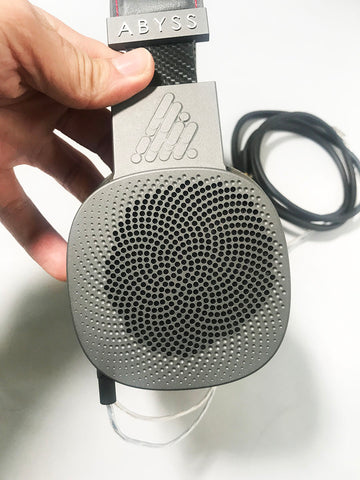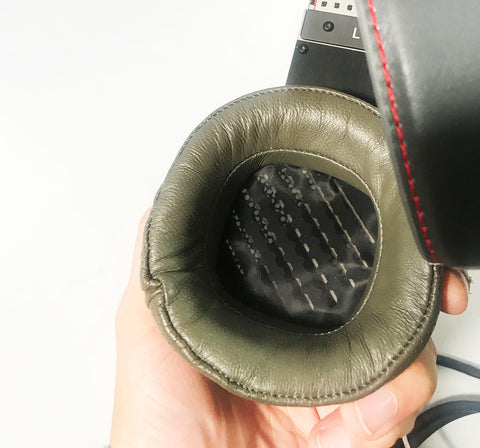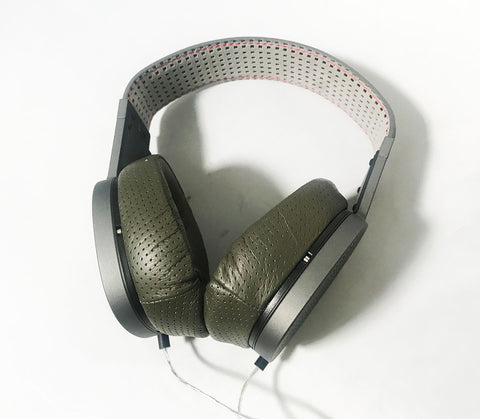The Abyss Diana Phi is one of the most highly regarded headphones in the audiophile community right now. So when I got the chance to spend some time with it this week, I was elated to try them out! But at such a high price point of nearly $4000, is it really worth it? Let’s take a closer look at them today with this Abyss Diana Phi Review.
Abyss Diana Phi Review
In the Box
-Abyss Diana Phi Headphones
-Detachable cable with 3.5 mm termination
-3.5 mm to 6.35 mm adapter
-Zipping carrying case
-Documentation
Design
Headband

The headband of the Abyss Diana Phi is thin, flexible, and strong. Coated in leather across the top, it magnetically adjusts to the contour of the head.This adjustment doesn’t result in a tight clamp, but rather a secure, easy fit. Additionally, it has a layer of perforated alcantara on the underside. As a result, it is soft to the touch. Additionally, it distributes the weight smoothly, and takes some of the weight out of the earcups. Underneath the Abyss logo, carbon fiber extenders attach to the aluminum frame. However, I found it works best for those with average to large size heads. As someone with a smallish head, the smallest size was a little bit too large for me.
Earcups

The earcups of the Abyss Diana Phi have a rounded square shape. Made of aluminum, they have a little bit of weight to them in the hands. Their overall look is interesting, because while their gray color gives them a simple, classy look, the design of the logo and Fibonacci hole design makes them more intricate and expensive looking. Additionally, a translucent film screen protects the drivers inside. They are visible by looking toward them from the inside of the earcups.
Earpads

The earpads of the Abyss Diana Phi are made of a firm, bouncy foam which are coated in perforated leather. They have a round shape which contrasts interestingly from the squarish shape of the earcups. The walls of the earpad are asymmetrical, sloping outward from the earcup and coming to almost a soft point. As a result, the earpads help to avoid ear contact with the earcup.
Drivers
The Abyss Diana Phi is a planar magnetic headphone. It utilizes patent-pending Phi drivers, which became popular with Abyss’s flagship headphone, the AB-1266 Phi CC. These drivers have low-mass diaphragms. Additionally, they have a fast low-end response and can reproduce subtle, nuanced detail according to Abyss.
Cable

The cable of the Abyss Diana Phi is made by JPS Labs and is available balanced or unbalanced with various termination connectors. There isn’t much information available about the cables online, but they feel strong and durable in the hands. Additionally, their lengths are customizable, and are easy to manage and wrap.
Sound

Low Frequencies
The low frequencies of the Abyss Diana Phi have extension, quickness, and clarity. A boost around what sounded like 30-40 Hz gave extra feeling to kick drums and bass synths. This boost combined with a feeling of quickness gave low frequency rich instrument groove and emotional impact for mixes that utilize low frequencies for such things. Additionally, the spaciousness around the lows leaves room for the low-mids to provide foundational support for mixes, while maintaining the depth and detail to give it dimensionality and nuance.
For example, when I was listening to the song Cleva by Erykah Badu, the kick drum sounded deep with extension. However, it maintained clarity and tightness because of how quick the speaker responded. As a result, it had a tight sense of groove alongside the bass guitar. Both had their own space, and were able to contribute to the mix in their own ways.
Middle Frequencies
The midrange of the Abyss Diana Phi is full, warm, and harmonically complex. Strings, keys, guitars, and horns have a sense of realism from their harmonic complexity and dynamic expression, but also have a sense of warmth and smoothness. A small boost around what sounded like 400 Hz provided an even greater sense of thickness. As a result, synths and electric guitars seem to take up slightly more space, but come through with a feeling of power and energy. Additionally, boosts at the base of the high-mids, around 1 kHz and in the middle of the high mids around 3 kHz provide presence and articulation. However, cuts in between them around 2 kHz and 4 kHz help to balance the level of the high-mids so vocals still sit accurately in the mix level-wise.
For example, when I was listening to the song Born of a Broken Man by Rage Against the Machine, the guitars came through with lots of thickness, power, and harmonic complexity. This contributed to their role in the song, and gave them the strength to uphold the song’s emotional goals. And while they had a sense of detail, they also felt smooth and warm. This gave them an added feeling of aesthetic pleasingness, while maintaining the detail to keep them realistic sounding. The vocal sat accurately placed in the mix, but had more emphasis in the chest and throat than the face.
High Frequencies
The high frequencies of the Abyss Diana Phi are smooth and easy sounded, with harmonic complexity and realism, but a little bit of a moderate level. Additionally, a boost in the lower treble provides a little bit of extra presence to vocals, horns, cymbal attacks, and piano hammers. It provides articulation and helps with spatial specificity. Additionally, a small boost around what sounded like 8 kHz provides textural detail to percussion, the strums of acoustic guitars, vocal rasps, and cymbals. However, this boost is balanced by another just above it at what sounded like 9 kHz, which lets that texture sit back in space at an appropriate and more accurate level. Lastly, a boost around what sounded like 10-12 kHz provided a sense of extension and subtle air. As a result, mixes had a general sense of lift, although the boost itself didn’t add to a feeling of extra loudness in the highs. The high frequency response of the cans was actually kind of interesting because while there was a lot of detail in the highs, its level sat somewhat moderately in the mix level-wise relative to the midrange and lows.
For example, when I was listening to the song Miles Runs the Voodoo Down by Miles Davis, the highs of the horns, shaker, and cymbals sounded realistic and harmonically complex. The exact character of their unique timbres came through clearly, with spaciousness around them. However, the highest parts of those instruments sounded slightly quieter in the mix compared to the keys and bass guitar. Additionally, the trumpet, keys, and electric guitars sat with a little bit of added presence. The attack of the cymbals poked through with clarity, but with an appropriate level.
Soundstage
The soundstage of the Abyss Diana Phi had an expansive sense of depth and width. While it had a strong feeling of phantom center and a little bit of added presence due to the lower treble boost, an emphasis on the depth and width which gave the sound a fun and dramatic soundstage. Additionally, because of the subtle, yet nuanced sense of extension in the highs and lows, the height had nuance to its spatiality. It reached up nice and high above the head and deep down below the chest.
For example, when I was listening to the song Fever by Ray Charles featuring Natalie Cole, the intimate lead vocals contrasted very strongly from the guitars, rhodes, bass, strings, and horns which far off in space. But even the vocals, while present, sound slightly off from the ears as opposed to directly in the face. Additionally, the centered vocals and bass contrast strongly from the wide-panned guitars, rodes, horns, and strings which feel like they reach far out beyond the head. Lastly, the lows of the bass reach down below the chest, while the highs of the sizzling cymbals reach up above the head. The midrangey rhodes, guitars, and horns sit in between those extremes, with the vocal sitting just above them in space. This specificity contributes to the lovely sense of separation between each instrument, and contributes to the emotional impact of the song.
Overview
Overall, the Abyss Diana Phi has a nice thick, harmonically complex sound, particularly in its midrange, with a lot of tight detail in the highs and lows. It has both a sense of warmth and detail, with a little bit of a sense of moderation in the highs level-wise. Its soundstage is deep and expressive and dramatic in its presentation. The Diana Phi works well with a wide variety of genres, although I particularly loved it for rock, jazz, and pop.


 FREE Shipping
FREE Shipping




